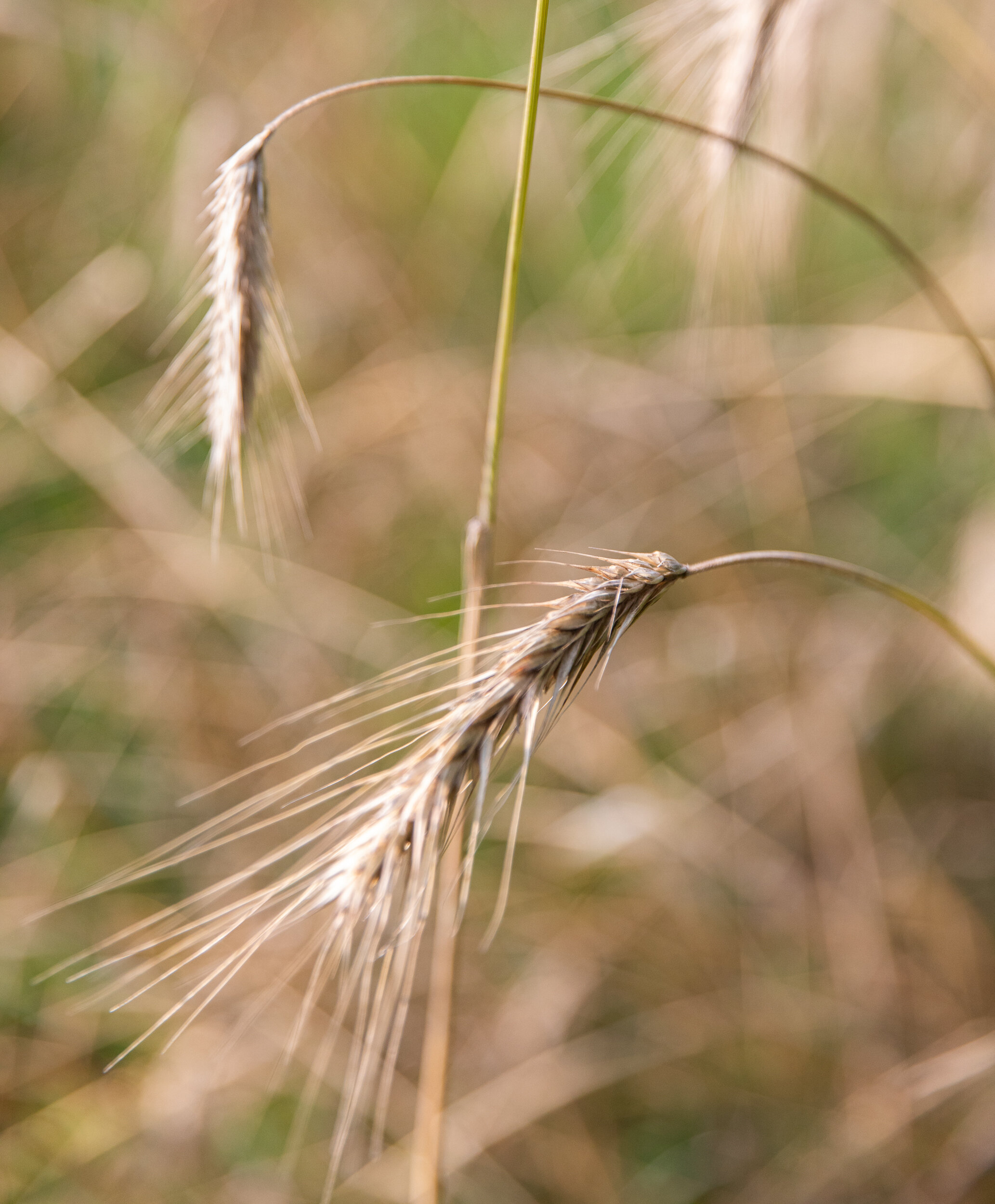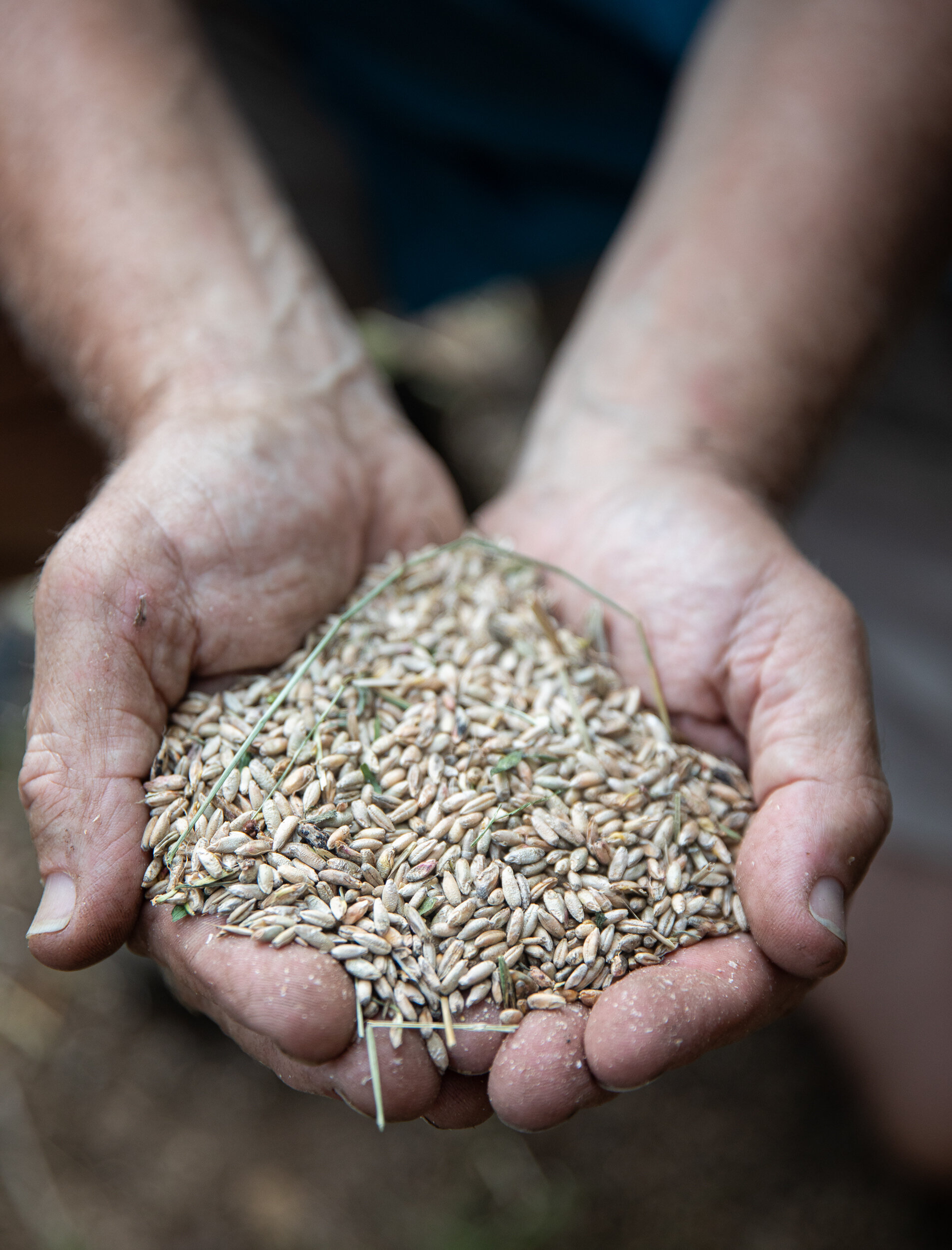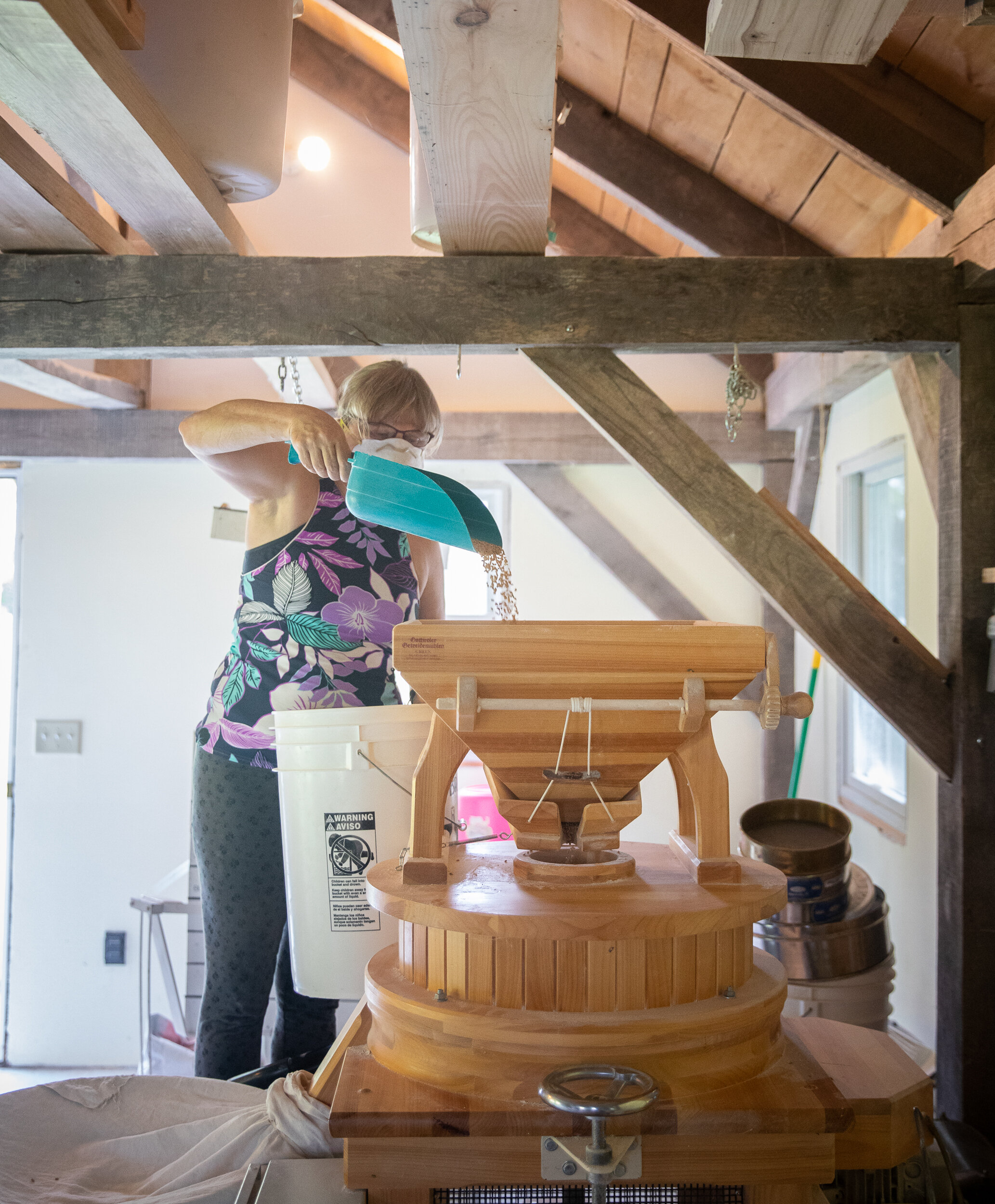Going With The Grain: Whitesfields Farm Carries On The Old Traditions With Wheat and Rye
Photos by Little Outdoor Giants
A visit to Whitesfields Farm in Hardwick is very nearly a trip back in time. The town itself was incorporated in 1732; the annual Hardwick Community Fair, held in late August for the past 259 years, is the oldest agricultural fair in the country.
The farm is on a long, narrow road bordered by ancient oak trees and 300-year-old stone walls. On the right stretches a field where, earlier this summer, three and half acres of golden Redeemer wheat stalks shimmered in the breezy sunshine. Just beyond this year’s wheat field stands the Whites’ farmhouse, a post-and-beam construction by a local builder. The deck outside the kitchen beholds a vista of rolling green fields and the hills of the Quabbin Reservoir and beyond.
Stan and Abbie White began farming and raising their two sons on this beautiful site 31 years ago, but the land has been cultivated since the 1700s. As farmers in Central Massachusetts did more than 200 years ago, the Whites grow wheat and rye. They also harvest plums, pears and pawpaws from a handful of fruit trees. Most of their land is managed forest; only six acres are planted with grain.
Abbie White researched and found in the 1840 Agricultural Census of Massachusetts that the state produced almost 5,000 tons of wheat that year. “Today, this would be one thousand farms growing wheat like us,” she says. In reality, the Whites are the only wheat farmers in Central Massachusetts who produce high-quality grain for a few bakeries and a loyal following of home bakers.
Just as farmers in the past, the Whites’ small-scale, family-run operation includes livestock. Their flock of 25 Border Leicester and Scottish Blackface sheep as well as 50 lambs are herded by two diligent border collies. The sheep are raised for meat but they also play an important role in the development of the grain crops, which are rotated, planted in different fields every September.
“When we finish the harvest, the sheep come through and eat the remainder. We let the fields go for two or three years; when the land is ready to be rototilled there aren’t any weeds,” Abbie says. “We don’t need to fertilize or spray with chemicals.” The farm is not certified organic, but the Whites follow sustainable practices.
Their two sons, Simon and Evan, grew up caring for sheep and along with their parents learned the process of planting, harvesting and milling grains. Adults now, the White sons have their own careers: Simon and his wife, Melissa, are pharmacists and Evan is an engineer. Yet they’re still involved in the farm and return every year to help with the harvest.
“It’s so rewarding that they still love to farm,” Abbie says. “This is what our family has chosen to do together.” Like their sons, Stan and Abbie White also have other jobs “to pay the bills,” she adds. Stan is president and CEO of Caprilogics, which produces antibodies for research; Abbie formerly managed a research laboratory at Worcester Polytechnic Institute and is now an administrator at Smith College.
The Whites both have agriculture in their backgrounds. Abbie grew up in a nature-loving family on an organic farm in Lincoln. Stan graduated from the University of Wisconsin with a degree in agriculture. The couple were living in Minnesota when Abbie’s mother sent them a help-wanted ad from a local newspaper for a farm manager at the Codman Community Farm in Lincoln. “We packed up and moved back east,” Abbie says. At the farm, Stan improved breeding stock as he raised sheep and border collies. When land that is now their own farm became available, they moved to Hardwick in 1990.
Growing wheat originated as Stan’s hobby project. He wanted to brew beer from locally sourced ingredients. Abbie was already growing hops, but Stan’s first crop of barley was not a success. They fed it to the local wild turkeys instead. He next planted 50 pounds of wheat berries, harvesting with a scythe, only to produce 50 pounds of grain.
In 2012 the couple attended the University of Vermont grain-growing events and met Ben Gleason, the Northeast’s pioneer organic wheat farmer. They toured Gleason’s farm, were impressed by his Redeemer variety of winter wheat and decided to follow the model of his small-scale, one-man operation.
“Ben helped us obtain our Redeemer wheat seed for the first three years,” says Abbie. “We now save our own seed and as our grain adapts and changes for the Hardwick climate, eventually we will be growing a truly local wheat variety.”
As they increased the farm’s acreage devoted to grain, the Whites realized they needed to upgrade from the scythe they’d purchased for harvesting their first crop. Stan bought a 1959 Allis-Chalmers combine and rebuilt it with the help of his son, Evan. They added a 100-year-old clipper mill to clean the wheat berries and Evan worked with a fabrication company in Worcester to custom manufacture a leather belt to turn the wooden mechanism.
In recent years, the Whites have harvested about 8,000 pounds of grain annually. “We could easily double our yield on the amount of land we have,” Stan says, “but that would change our entire operation” and he’s loath to ramp up production.
Over the past six years word of the Whites’ high-quality grain (tested and rated annually by the University of Vermont Grain Laboratory) spread throughout Central Massachusetts and beyond. Earlier this year, famed chef Dan Barber’s restaurant, Blue Hill at Stone Barns in Tarrytown, NY, bought 300 pounds of the Whites’ flour for baking biscuits. Since 2015 the wheat berries sold at Elmendorf Baking Supplies and Café in Cambridge have come from the Whites, who also sell them to Fire Dog Breads in Keene, NH.
After sampling the Whites’ flour, Glenn Mitchell, owner of Rose 32 Bakery in Gilbertville, helped them find a mill big enough for commercial capacity. The Osttiroler Getreidemühlen, a beautiful wood-encased piece of equipment that looks like fine furniture, was imported from Austria. It grinds a pound of grain per minute and holds 50 pounds of grain.
To refine their whole-wheat flour, the Whites bought an antique sifter, manufactured in 1915 in North Carolina. The sifter takes out the bran to make bolted flour, which “has the nutrition and flavor of whole wheat without the heaviness and high levels of water absorption,” Abbie says. The farm’s milling operation is housed in a building that their oldest son, Simon, framed from felled trees on their property.
Just as farmers in the past, the Whites have frequently battled the weather. Some years drought threatened the grain crop and in others, they raced to harvest before thunderstorms could destroy the stalks. Nothing, however, matched the weather challenges of 2021.
The drought in early spring depleted the soil and was followed by blistering heat in June. Then the rains came. Normally the family gathers for harvesting the third week in July, but this year there wasn’t a day without rain—often pelting storms with fierce winds—until late in the month.
By the time Stan White could drive his 62-year-old combine up and down the rows of wheat as it reaped and threshed grain from the stalks, many of them had been beaten into the ground by the month of storms. Some wheat had already sprouted. “We’ve never seen that before,” Abbie says.
The Whites expected that this year’s crop would bring in between 8,000 and 8,500 pounds of grain, but now it’s wait and see until it dries and is tested for contamination. Although they have saved seed from the last two years’ harvests in order to plant next year’s crop, the farm is temporarily suspending sales of wheat berries and will inform its flour customers that there might not be enough for them this year.
“The biggest loss is having to disrupt our relationships with customers,” Abbie says. “It’s really upsetting to say no to them.”
If there is a silver lining to this year’s crop loss, it’s that the surviving wheat is likely stronger. “We noticed that the shorter stalks did much better,” Abbie says. “The wheat that is doing the best is adapting to the conditions on our farm.”
Stan is hopeful that the drying and cleaning process will salvage this year’s crop. He’s still optimistic about the future for growing grain in Central Massachusetts.
“There is a strong demand,” he says. “There’s more business out there than we can handle and there are a lot of grain varieties we’re not growing. “
“We encourage young farmers to get into grain growing,” he adds. “Start small and learn from your mistakes. It takes at least five years to hit your rhythm.”
This story appeared in the Fall 2021 issue.







